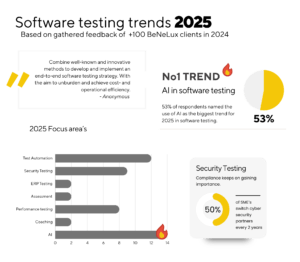
1. Automation testing
Automation testing has become a steady key enabler of success, staying relevant as it adapts to the increasing demands for faster and more efficient software delivery.
As technologies evolve and the complexity of applications grows, automation continues to be ever-evolving, incorporating new methodologies, tools, and technologies such as AI, low-code testing platforms, and self-healing capabilities.
2. Artificial Intelligence (AI) and Generative AI (Gen AI) in testing
The explosion of AI-driven solutions has propelled AI to the forefront of testing. With the ability to process large datasets, identify patterns, and make predictive decisions, these technologies are transforming how we ensure software quality, enabling smarter, faster, and more efficient testing practices. Tools like e.g. SQAI-suite are making AI adoption more accessible to QA teams.
3. Shift-left and continuous testing strategies
Modern software development methodologies, such as Agile and DevOps, continue to drive the demand for effective test strategies that incorporate approaches like shift-left testing and continuous testing. Integrating quality assurance seamlessly into every stage of the software development lifecycle, ensuring faster delivery and higher-quality products.
Additionally, these test strategies must be tailored to address the unique challenges posed by complex situations and systems like ERP-platforms (e.g. SAP), which require robust and scalable approaches to testing.
4. Proactive security testing
The ever-growing number of data breaches and increasingly sophisticated cyberattacks ensure security testing remains a top priority. Organizations are under constant pressure to protect sensitive data, ensure compliance with regulatory standards, and maintain user trust. This makes security testing no longer optional—it’s an essential part of modern software development and has evolved to proactively identify vulnerabilities, simulate real-world attacks, and fortify applications and organizations against these threats. By integrating security practices early and throughout the lifecycle, organizations can ensure robust defenses while delivering high-quality software.
5. Performance testing
Performance testing remains a cornerstone of software quality assurance, ensuring that applications meet user expectations under varying conditions. With increasing user demands and the rapid spread of complex applications, performance testing is more critical than ever. Modern systems, from e-commerce platforms to ERP solutions, must handle high volumes of transactions and users without compromising speed or stability.
Recent advancements have elevated its importance even further, such as Continuous, Cloud-Based, Mobile, and IoT- Performance Testing.
6. Modern test data management
Test data management has long been a fundamental aspect of effective testing, but the increasing complexity of modern applications and the growing emphasis on compliance with privacy regulations have elevated its importance. The demand for accurate, diverse, high volume, and secure test data has never been greater. Consequently, test data management is evolving to keep pace with advancements in technology, regulatory requirements, and modern testing methodologies, making it more challenging and sophisticated than ever before. To keep up organizations should consider things like Synthetic Data Generation (with AI) and Virtualization, Data Masking and Anonymization (with AI), Continuous Data Integration (within CI/CD), etc.
Conclusion
As technology continues to evolve, staying up to date with emerging trends is essential. By understanding and leveraging these continuous advancements, testing teams can effectively navigate the challenges of modern software development and continue delivering high-quality applications in an increasingly competitive landscape.
Are you ready to adapt and thrive your software testing?